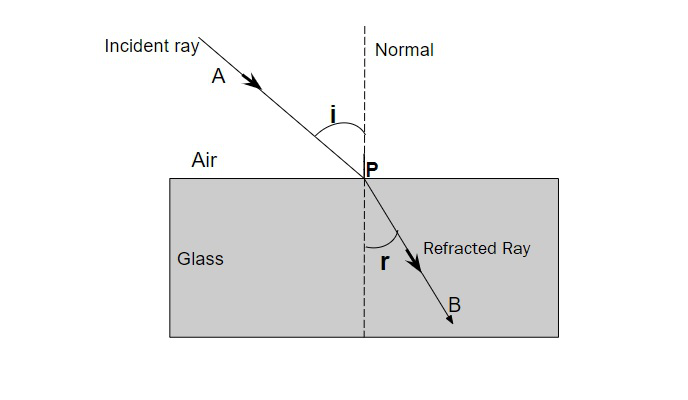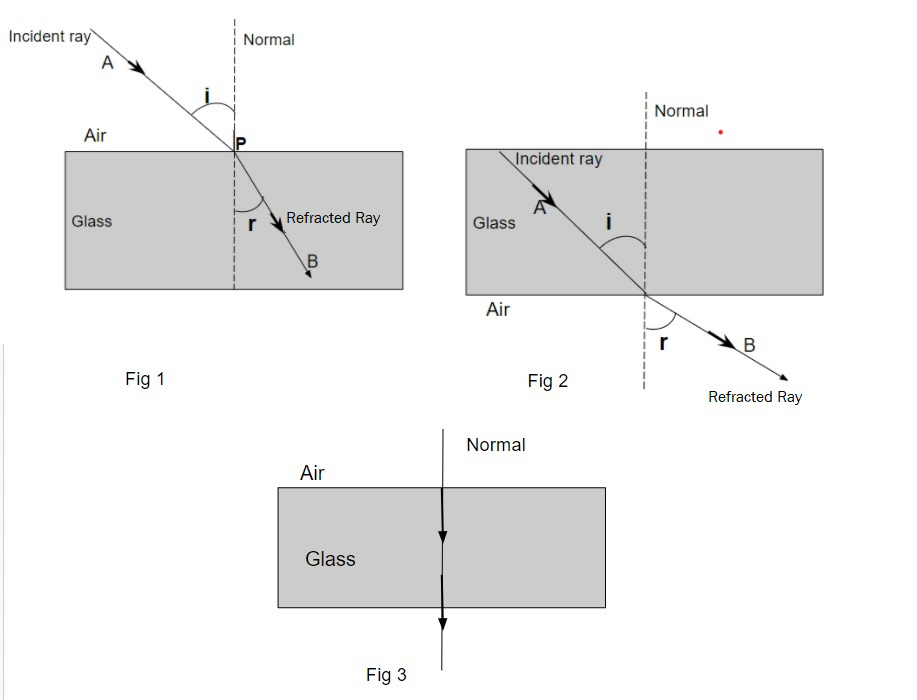光的折射定律
当您将铅笔放入一杯水中时,您可能会看到铅笔略微弯曲,但实际上并非如此。您可能还观察到,在夏季,空地另一侧的树木和房屋似乎在摇晃。在炎热的夏日在路上行驶时,您可能已经看到路中间突然出现了水,当您靠近时,已经没有水了。您可能还观察到日出和日落时太阳位置的明显变化。这一切背后的原因是“光的折射”。我们将在本文中讨论折射。
什么是光的折射?
The phenomenon of change in the direction/path of light rays when it travels from one transparent medium to another is called refraction of light.
光的弯曲是由波速的变化引起的。光在不同的介质中具有不同的速度。当光在同一介质中传播时,它沿直线传播,但当介质改变时,光速会发生变化并弯曲。
与光的折射相关的术语:

- 入射光线:在 P 点(上图)落到表面的光线称为入射光线(AP)。
- 折射光线:在玻璃中传播方向改变的光线称为折射光线(PB)。
- 入射角(i):入射光线与法线所成的角度称为入射角。
- 折射角(r):法线与折射角所成的角称为折射角。
光的折射图解

- 图1:入射角大于折射角(∠i > ∠r)。当一束光线从稀有介质传播到密度更大的介质时,它会向法线方向弯曲。空气较稀有介质,玻璃是较致密介质。
- 图2:入射角小于折射角(∠i <∠r)。当一束光线从密度较大的介质(玻璃)传播到密度较小的介质(空气)时,它会偏离正常方向弯曲。
- 图 3:当光线沿法线行进时没有偏转。 ∠i=∠r=0。
光的折射定律
First law of Refraction of Light – It states that the incident ray, refracted ray and normal to the interface at the point of incidence all lie in the same plane.
Second law of Refraction of Light: It states that the ratio of the sine of the angle of incidence and the sine of the angle of refraction is constant. It is given as,
sin i / sin r = constant
Snell’s law: It states that for the light if given colour and for the given pair of media, the ratio of the sine of the angle of incidence to the sine of the angle of refraction is constant. It gives the degree of refraction and also tells the relation between the angle of incidence, the angle of refraction and the refractive index of media.
sin i / sin r = μ = constant
where,
- μ is the refractive index of the medium.
折射率
折射率(用于速度):对于给定波长,真空中的光速与给定介质中的光速之比称为该介质的“折射率”。用“ μ ”表示。
μ = c/v
在哪里,
- c 是真空中的光速,并且
- v 是介质中的光速。
折射率(用于波长):光在真空中的波长与其在给定介质中的波长之比称为该介质的“折射率”。用“ μ ”表示
μ = λ v /λ m
在哪里。
- λ v是真空中的波长,并且
- λ m是介质中的波长。
折射率没有单位。
介质的折射率取决于:
- 光的波长
- 介质的性质
- 周围的性质
- 温度
光折射的应用:
- 用于制作门上的窥视孔、双筒望远镜、照相机、投影仪的镜头等。
- 用于矫正人眼屈光不正。
- 用于放大物体的图像或缩小物体的图像大小。
示例问题
问题1:为什么地平线附近的太阳在日出和日落时显得扁平?
回答:
The horizon appears flattened due to atmospheric refraction. The density and refractive index of the atmosphere decreases with increasing altitude. So, the rays of sun from the top portion and bottom portion are refracted by different degrees.
问题2:星星为什么会闪烁?
回答:
The stars twinkle due to the atmospheric refraction. The stars’ light under goes undergoes several refractions before reaching the earth, refraction regularly changing the refractive index that’s why it twinkles.
问题3:光的折射和反射有什么区别?
回答:
Reflection: The bouncing back of light from a smooth and shining surface is called reflection. Angle of incidence is equal to the angle of reflection. ∠i = ∠r.
Refraction: The bending of light rays, when it travels from one medium to another is called refraction of light. The angle of incidence and the refracted ray may or may not be equal.
问题4:空气对水的折射率是5/3。入射角为sin 50°。求折射角。
回答:
Given that,
i = 50°
μ = 5/3
Since,
μ = sin 50°/ sin r
sin r = sin 50° × (3/5)
= 0.766 × (3/5)
= 0.4596
r = sin-1(0.4596)
= 27.36°
Therefore, the angle of refraction will be 27.36°.
问题5:玻璃中的光速为2×10 8 m/s,空气中的光速为3×10 8 m/s。求玻璃的折射率。
回答:
Given that,
v = 2 × 108m/s
c = 3 × 108m/s
Since,
μ = c/v
Therefore,
μ = 3 × 108/ 2 ×108.
= 1.5
Therefore, refractive index will be 1.5
问题 6:为什么光线从空气到玻璃时会向法线方向弯曲?
回答:
As the speed of light in air is greater than the speed of light in glass. Hence, the ray of light bends towards normal when it passes from air to glass.